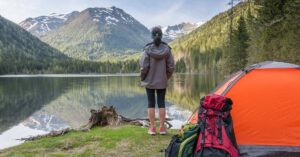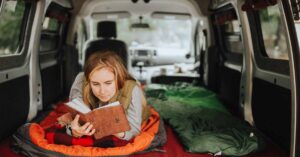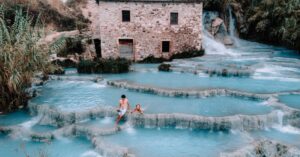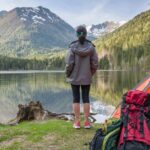Many people wonder about sleeping parks. It can be a cheap way to travel or camp. Some parks allow this, but others don’t. The rules and costs vary by park. It’s essential to realize what’s permitted before you go. This can assist you with trying not to fines or be approached to leave. We should see a few parks where you can rest in your vehicle and what it could cost.
Some national parks allow sleeping in your car. Costs vary from free to about $30 per night. State parks have different rules. Some permit car camping, others don’t. Many require a permit or fee. City parks usually don’t allow overnight stays. Rest areas on highways often let you sleep for free, but only for one night. Always check local rules before parking overnight.
Imagine waking up to a stunning sunrise in your sleep car. The gentle sound of nature surrounds you. Your wallet is still full. Sleeping parks in which you sleep in your car can make this dream real. It’s a budget-friendly way to explore the outdoors. But where can you do this legally? How much does it cost? Some parks welcome car campers. Others strictly forbid it. Knowing the right spots can save you money and trouble.
Which Sleeping Parks Always Allow Car Camping?
Death Valley National Park
Death Valley National Park is a remarkable spot to visit. It’s known for its outrageous intensity and distinct excellence. The recreation area offers many places where you can rest under the stars. You can park your car and sleep at several campgrounds in the park. Some are basic, while others have more amenities. The cost to sleep here ranges from $14 to $36 per night.
The recreation area permits you to rest in your vehicle at these campsites. This is an extraordinary method for remaining cool in the hot desert evenings. Make a point to bring a lot of water when you visit the recreation area. Demise Valley has a few regions where you can rest free of charge. These are called backcountry camping spots.
You need to park your car at least one mile from any road to use these.
Remember, the park gets very hot during the day.Resting in your vehicle or tent is best finished in cooler months. Continuously take a look at the recreation area’s site for current guidelines about where you can stop and rest.
Big Bend National Park
Big Bend National Park is a lovely spot in Texas. It’s known for its desert scenes and mountain views. The recreation area offers many spots where you can rest and appreciate nature. You can sleep in the park at several campgrounds.
Some let you park your car and set up a tent nearby. The cost to sleep here is about $16 per night. The park also has backcountry areas where you can sleep. You need a permit for these spots. Some of these areas let you park your car and sleep in it overnight.
Big Bend has different rules for where you can sleep in different seasons. In summer, it gets very hot. Many people prefer to sleep in the park during cooler months. When you sleep in the park, you might hear coyotes at night. You could see stars fill the sky. Always check the park’s rules before you plan to sleep there. This way, you can have a safe and fun time in Big Bend National Park.
Great Smoky Mountains National Park
Great Smoky Mountains Public Park is a well known spot in Tennessee and North Carolina. It’s known for its foggy mountains and various untamed life. The recreation area offers many spots to rest and appreciate nature.
You can sleep in the park at several campgrounds. Some let you park your car and set up a tent nearby. Surprisingly, it’s free to sleep in many areas of this park. The park allows backcountry camping too. This means you can sleep deep in the woods. You need a permit for this, but it’s also free. Some spots let you park your car and sleep in it overnight.
When you sleep in the Great Smoky Mountains National Park, you might hear owls at night. You could see fireflies in summer. The park is beautiful in all seasons, so you can sleep there year-round.
Yellowstone National Park
Yellowstone Recreational area is a well known park in Wyoming, Montana, and Idaho. It’s known for its wellsprings, underground springs, and regular life. Many individuals visit Yellowstone every year to see its regular marvels.
The diversion region has many sleeping parks where you can stay for the present. There are campgrounds where you can nap tents or RVs. A couple of lodgings are similarly in the entertainment region for individuals who would prefer not to camp. Yellowstone is home to numerous creatures. You could see buffalo, elk, or even bears. Staying away from natural life in the park is significant.
The park changes with the seasons. Summer is busy and warm. Winter is quiet and cold, with many roads closed. Spring and fall offer fewer crowds and beautiful colors. Each season gives a different way to experience Yellowstone.
U.S. National Forests
U.S. National Forests are large areas of public land across America. They offer many places to park and sleep in nature. These forests are different from national parks but still great for outdoor adventures.
Most National Forests allow you to sleep in your car or tent. This is often called dispersed camping. It’s usually free to park and sleep this way. You can stay up to 14 days in most spots. Some National Forests also have campgrounds. These areas may have more rules about where you can park and sleep. They might charge a small fee, usually between $5 to $20 per night.
Before you park and sleep in a National Forest, check the local rules. Each forest can have different guidelines. Some areas might be closed for wildlife or fire safety. Always have a backup plan for where to sleep in case your first choice doesn’t work out.
Bureau of Land Management
The Agency of Land The board (BLM) oversees immense public grounds in the US. These regions offer many spots to stop and rest free of charge or for minimal price. BLM lands are great for those who love open spaces and simple camping.
On most BLM land, you can park your car and sleep for free. This is called dispersed camping. You can usually stay up to 14 days in one spot. There are no set campsites, so you can often choose where to park.
Some BLM areas have developed campgrounds. These might have basic facilities like toilets and fire rings. You can park and sleep at these spots for a small fee, often between $5 and $20 per night.
When you sleep on BLM land, you’re truly in the wild. You might see amazing starry skies at night. During the day, you could spot wildlife or enjoy hiking. Remember to bring everything you need, including water.
Before you park and sleep on BLM land, check local rules. Some areas have fire restrictions or are closed to camping. Always practice Leave No Trace principles to protect these public lands. BLM websites or local offices can give you up-to-date information on where to park and sleep.
Public Parking
Public parking lots can sometimes be an option for sleeping in your car. These include rest areas on highways, some Walmart parking lots, and certain city or town parking areas. However, rules vary widely from place to place.
Many public parking lots don’t allow overnight stays. Some may have time limits or require permits. It’s important to check local laws and any posted signs before parking to sleep. Some places may be noisy or unsafe for overnight stays. Always prioritize your safety when considering sleeping in public parking lots.
Joshua Tree National Park
Joshua Tree Public Park is an exceptional desert park in California. It’s known for its odd looking Joshua trees and enormous stone arrangements. Many people visit to hike, climb rocks, and sleep under the stars.
The park has several campgrounds where you can park and sleep. Some let you reserve spots ahead of time. Others are first-come, first-served. It costs between $15 to $20 each night to rest at these campsites.
You can rest in a tent or your vehicle at Joshua Tree. Certain individuals like to rest in their vehicles since it’s hotter around evening time. The desert can get very cold after dark.
The park is a great place to see stars at night. Many individuals come just to rest in the recreation area and take a gander at the night sky. It’s actually dim, so you can see a greater number of stars than in a city.
Before you park and rest in Joshua Tree, really take a look at the recreation area’s principles. A few regions may be shut. In active times, camping areas can top off quickly. It’s smart to have a plan B for where to rest in the event that the recreation area is full.
Olympic National Park
Olympic National Park is a diverse park in Washington state. It has mountains, rainforests, and beaches. Many people visit to hike, see wildlife, and sleep in nature.
The park has several campgrounds where you can park and sleep. Some are in the forests, others near the beach. It costs about $20 to $24 per night to sleep at these campgrounds.
You can sleep in a tent or your car at Olympic National Park. Some campgrounds have spots for RVs too. Remember, the park can be rainy, so bring waterproof gear if you plan to sleep outside.
The park also allows backcountry camping. This means you can hike into the wilderness and sleep there. You need a permit to do this. Some people like to park their cars and then hike to sleep in more remote areas.
Before you park and sleep in Olympic National Park, check the park’s website. Some areas might be closed due to weather or wildlife activity.In summer, camping areas can top off quick. It’s shrewd to have a plan B for where to rest in the event that your best option is full.
Read more About:
Baja California Sur
Frequently Asked Question
Is it legitimate to rest in my vehicle at public parks?
Most public parks permit dozing in your vehicle at assigned camping areas, yet governs change.
What amount does it cost to rest in my vehicle at a recreation area?
Costs range from free to about $40 each evening, contingent upon the recreation area and offices.
Could I at any point rest in my vehicle for nothing in any parks?
Indeed, a few regions like BLM lands and certain public timberlands frequently permit free short term visits.
Conclusion
Sleeping in your car at parks can be a fun and cheap way to travel. Many parks allow it, but rules and costs differ.Public parks, woods, and BLM lands frequently have spots for vehicle setting up camp. Costs range from free to about $40 each evening.Always check park rules before you go.
Remember to respect nature and follow safety guidelines. With some preparation, you can appreciate delightful open air spaces without spending a lot of on housing. Vehicle setting up camp in leaves offers a novel method for investigating America’s normal marvels.



















